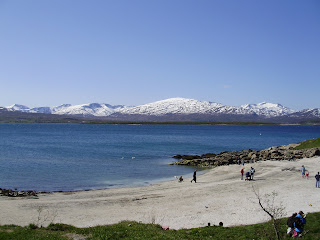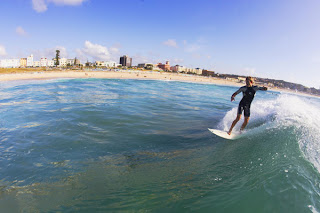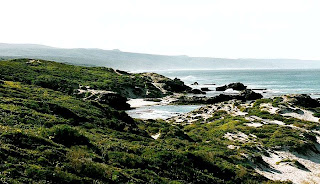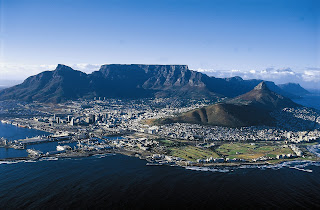 |
| Table Mountain |
Table Mountain is Cape Town's most prominent feature and a world famous landmark. This majestic mountain is visible from almost everywhere in Cape Town and is often used as a beacon by which to find direction. It's tabular shape results from nearly horizontal layers of sandstone exposed by vigorous wind and water erosion. The distinctive-looking mountain is one of Cape Town’s most recognized landmarks and is a popular tourist attraction that offers hiking, camping, and other activities.
Table Mountain has its own cloud cover (the Tablecloth), forming rapidly when the wind is in the southeast and mainly responsible for the lush plateau vegetation. Five mountain reservoirs catch the rainfall brought by northwesterly winds in winter (ranging annually from 60 inches at the summit to 22 inches at the base).
 |
| Night View of Table Mountain |
The main feature of
Table Mountain is the level plateau approximately 3 kilometres from side to side, edged by impressive cliffs. The plateau, flanked by Devil's Peak to the east and by Lion's Head to the west, forms a dramatic backdrop to Cape Town. This broad sweep of mountainous heights, together with Signal Hill, forms the natural amphitheatre of the City Bowl and Table Bay harbour. The highest point on Table Mountain is towards the eastern end of the plateau and is marked by Maclear's Beacon, a stone cairn built in 1865 by Sir Thomas Maclear for trigonometrical survey. It is 1,086 metres (3,563 ft) above sea level, about 19 metres (62 ft) higher than the cable station at the western end of the plateau.
 |
| Table Mountain port | |
By the late 1870's, several of Cape Towns more prominent (and possibly less fit) citizens had suggested the introduction of a railway line to the top. Plans to implement a proposed rack railway got under way but the outbreak of the Anglo-Boer war put a halt to the plans. By 1912, with a strong desire to gain easy access to the top of Table Mountain, the Cape Town City Council commissioned an engineer to investigate the various options of transport to the top. The engineer, a Mr. H.M. Peter, suggested that a funicular railway running up from Oranjezicht through Platteklip gorge would be the most suitable option. A vote was held with the vast majority of Cape Town's residents voting in favour. This in spite of its cost a staggering (in 1913) 100000 Pounds.
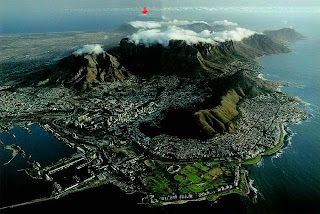 |
| Table Mountain - tablecloth |
The
Table Mountain project was delayed yet again by war; this time the outbreak of the First World War (1914-1918). The plan was resuscitated in 1926 after a Norwegian engineer, Trygve Stromsoe, presented plans for a cableway to the top of Table Mountain. The plan caught the collective eye of a group of eminent local businessmen. The idea that an easy route up would finally become a reality drew them together, forming the Table Mountain Aerial Cableway Company (TMACC) to finance the construction. Work began soon afterwards and the project was finished relatively quickly. On the 4th of October 1929, the Mayor of Cape Town, Rev A J S Lewis, headed the official opening ceremony that was attended by over 200 other guests.
 |
| Table Mountain |
Outdoor Equipment
Since it's opening in 1929, over 16 million people have taken the trip to the top of
Table Mountain. The
Table Mountain cableway has since become something of a landmark in Cape Town, and has carried some of Cape Town's most illustrious visitors including King George VI and Queen Elizabeth II, as well as Oprah Winfrey, Sting, Stefi Graf, Arnold Schwarzenneger, Magaret Thatcher, Prince Andrew, Micheal Schumacher, Brooke Shields, Micheal Buble, Tina Turner, Jackie Chan, Dolores O'Riordan, Skunk Anansie and Paul Oakenfold. In 1993, Dennis Hennessy, the son of one of the founders of TMACC sold the company. The new directors immediately set about planning an upgrade to the existing Table Mountain infrastructure.
Readmore..






